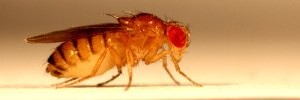Contact
Email: thlindsay1 at gmail dot com
Website: www.theodorelindsay.com
Research
A brain may see the world, feel the world or even ponder the nature of its own existence — all with little consequence unless it has a body that it may move within the world. For this reason, motor control is a central problem in systems neuroscience. I find the fruitfly — with its capacity to navigate into a well guarded kitchen or evade an attacking flyswatter — a paradigm of such control over movement. My hope is that understanding a bit of this complex motor system will shed light on the problem of motor control in general.
As actuators, muscles serve as the gateway between the nervous system and behavior. The engine for flight in the fly is provided by a set of large stretch-activated muscles whose coupled contractions resonate to deform the entire thorax and drive the wingstroke at nearly 200 times a second. Whereas the nervous system of the fly may throttle the power output of these large muscles over long timescales, a second set of smaller muscles that exert their action directly on the wing hinge appear to be responsible for dexterous areal maneuvers. Though size of this collection of ‘steering’ muscles is tractable (<20 muscles), the work cataloging their physiological and biomechanical properties has been limited to the largest members of the collection due to the technical challenge of placing electrodes near small and inaccessible targets.
Fortunately, recent developments in fruit fly genetics have provided a suite of tools for recording and manipulating the activity of excitable tissue such neurons and muscles. This combined with an expanded set of methods for behavioral analysis, present possibilities for new advances in understanding the fruit-fly flight motor.
Publications
Faumont, S., Lindsay, T. & Lockery, S. Neuronal microcircuits for decision making in C. elegans. Current Opinion in Neurobiology (2012).doi:10.1016/j.conb.2012.05.005
Lockery S.R., Hulme S.E., Roberts W.M., Robinson K.J., Laromaine A, Lindsay T.H., Whitesides G.M., Weeks J.C. A microfluidic device for whole-animal drug screening using electrophysiological measures in the nematode C. elegans.Lab Chip 12, 2211–2220 (2012).
Goodman, M. B., Lindsay, T., Lockery, S. R. & Richmond, J. E. Electrophysiological methods for Caenorhabditis elegansneurobiology. Methods Cell Biol. 107, 409–436 (2012).
Lindsay, T., Thiele, T. R. & Lockery, S. R. Optogenetic analysis of synaptic transmission in the central nervous system of the nematode Caenorhabditis elegans. Nature Communications 2, 306–9 (2011).
Sevcik M.A.*, Jonas B.M.*, Lindsay T.H.*, Halvorson K.G., Ghilardi J.R., Kuskowski M.A., Mukherjee P., Maggio J.E., Mantyh P.W. Endogenous opioids inhibit early-stage pancreatic pain in a mouse model of pancreatic cancer.Gastroenterology 131, 900–910 (2006).
Lindsay T.H., Jonas B.M., Sevcik M.A., Kubota K., Halvorson K.G., Ghilardi J.R., Kuskowski M.A., Stelow E.B., Mukherjee P., Gendler S., Wong GY., Mantyh P.W. A quantitative analysis of the sensory and sympathetic innervation of the mouse pancreas. Neuroscience 137, 1417–1426 (2006).
Lindsay T.H., Jonas B.M., Sevcik M.A., Kubota K., Halvorson K.G., Ghilardi J.R., Kuskowski M.A., Stelow E.B., Mukherjee P., Gendler S., Wong GY., Mantyh P.W. Pancreatic cancer pain and its correlation with changes in tumor vasculature, macrophage infiltration, neuronal innervation, body weight and disease progression. Pain 119, 233–246 (2005).
Sevcik M.A., Ghilardi J.R., Peters C.M., Lindsay T.H., Halvorson K.G., Jonas B.M., Kubota K., Kuskowski M.A., Boustany L., Shelton D.L., Mantyh P.W. Analgesic efficacy ofbradykinin B1 antagonists in a murine bone cancer pain model. J Pain 6, 771–775 (2005).
Halvorson K.G., Kubota K., Sevcik M.A., Lindsay T.H., Sotillo J.E., Ghilardi J.R., Rosol T.J., Boustany L., Shelton D.L., Mantyh P.W. A blocking antibody to nerve growth factor attenuates skeletal pain induced by prostate tumor cells growing in bone. Cancer Res. 65, 9426–9435 (2005).
Sevcik M.A., Ghilardi J.R., Peters C.M., Lindsay T.H., Halvorson K.G., Jonas B.M., Kubota K., Kuskowski M.A., Boustany L., Shelton D.L., Mantyh P.W. Anti-NGF therapy profoundly reduces bone cancer pain and the accompanying increase in markers of peripheral and central sensitization. Pain 115, 128–141 (2005).
Ghilardi J.R., Rorhrich H., Lindsay T.H., Sevcik M.A., Schwei M.J., Kubota K., Halvorson K.G., Poblete J., Chaplan S.R., Dubin A.E., Carruthers N.I., Swanson D., Kuskowski M., Flores C.M., Julius D., Mantyh P,W. Selective blockade of the capsaicin receptor TRPV1 attenuates bone cancer pain. J. Neurosci. 25, 3126–3131 (2005).
Peters, C.M., Ghilardi, J.R., Keyser, C.P., Kubota, K., Lindsay, T.H., Luger, N.M., Mach, D.B., Schwei, M.J., Sevcik, M.A., Mantyh, P.W. Tumor-induced injury of primary afferent sensory nerve fibers in bone cancer pain. Exp. Neurol.193, 85–100 (2005).
Peters, C.M., Lindsay, T.H., Pomonis, J.D., Luger, N.M., Ghilardi, J.R., Sevcik, M.A., Manyh, P.W. Endothelin and the tumorigenic component of bone cancer pain. Neuroscience 126, 1043–1052 (2004).
Education
Ph.D. Biology, University of Oregon, 2012
B.S., Biology, Stonehill College, 2000

